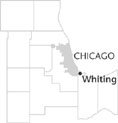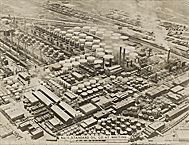| Entries |
| W |
|
Whiting, IN
|
 Lake County, 16 miles SE of the Loop. In 1889 the Standard Oil Company decided that it needed a
refinery
west of Cleveland to serve its growing kerosene and lubricant trade in the interior of the country. Company officials selected a site south of down- town Chicago on Lake Michigan filled with large sand ridges and populated by some 50
German
families who hunted, fished, and supplied lodging and meals to the many sportsmen who used the area. The settlement of Whiting itself dates to 1871 when a post office was established at the place where “Old Pap Whiting,” a conductor on the Lake Shore
Railroad,
had wrecked his train.
Lake County, 16 miles SE of the Loop. In 1889 the Standard Oil Company decided that it needed a
refinery
west of Cleveland to serve its growing kerosene and lubricant trade in the interior of the country. Company officials selected a site south of down- town Chicago on Lake Michigan filled with large sand ridges and populated by some 50
German
families who hunted, fished, and supplied lodging and meals to the many sportsmen who used the area. The settlement of Whiting itself dates to 1871 when a post office was established at the place where “Old Pap Whiting,” a conductor on the Lake Shore
Railroad,
had wrecked his train.

|
Refinery jobs proved especially attractive to immigrants and led to the creation of a community marked by ethnic diversity. The workforce soon consisted of Americans, Croatians, Finns, Germans, Hungarians, Irish, Poles, Russians, and Slovaks, who were probably the largest ethnic group to settle in the town. As in most industrial plants of the time, native-born skilled workers held the best jobs, and unskilled toilers, like Croatians and Slovaks, did the hot, dirty task of cleaning the refinery stills.
Standard Oil of Indiana dominated the life of the town throughout the twentieth century. Its Industrial Relations Plan, created in 1919, gave workers stock-purchase plans, health insurance, retirement programs, and a community center complete with gymnasium and pool which still serves the community. Families who benefited from these plans valued them greatly and many households even in the 1990s continued to receive Standard Oil pensions. During the Great Depression the company attempted to employ as many workers as possible, even if for only a few days a week.
A turning point in the life of Whiting came in 1955 when an explosion started a fire at the plant so massive that it could be seen from downtown Chicago. The damage caused the company to modernize the facility in a way that reduced the demand for employees and led to layoffs in the early 1960s. Families accustomed to good benefits and stable employment were now angered enough to support a union outside the control of the company for the first time: the Oil, Chemical and Atomic Workers. Nevertheless, levels of employment continued to drop. The population fell from 10,880 in 1930 to 5,137 by 2000, with most of the loss coming after 1950. As the children of the first immigrant wave left to find work elsewhere, Mexican Americans moved in to take what positions were available.
| Whiting, IN (inc. 1895) | |||||
| Year |
Total
(and by category) |
Foreign Born | Native with foreign parentage | Males per 100 females | |
| 1900 | 3,983 | 40.1% | 6.2% | 148 | |
| 3,978 | White (99.9%) | ||||
| 2 | Negro (0.1%) | ||||
| 3 | Chinese (0.1%) | ||||
| 1930 | 10,880 | 25.2% | 42.5% | 123 | |
| 10,865 | White (99.9%) | ||||
| 15 | Other (0.1%) | ||||
| 1960 | 8,137 | 10.3% | 27.6% | 105 | |
| 8,134 | White (100.0%) | ||||
| 2 | Negro (0.0%) | ||||
| 1 | Other races (0.0%) | ||||
| 1990 | 5,155 | 6.3% | — | 95 | |
| 4,720 | White (91.6%) | ||||
| 17 | Asian/Pacific Islander (0.3%) | ||||
| 418 | Other race (8.1%) | ||||
| 730 | Hispanic Origin* (14.2%) | ||||
| 2000 | 5,137 | 10.8% | — | 92 | |
| 4,488 | White alone (87.4%) | ||||
| 29 | Black or African American alone (0.6%) | ||||
| 15 | American Indian and Alaska Native alone (0.3%) | ||||
| 47 | Asian alone (0.9%) | ||||
| 4 | Native Hawaiian and Other Pacific Islander alone (0.1%) | ||||
| 467 | Some other race alone (9.1%) | ||||
| 87 | Two or more races (1.7%) | ||||
| 1,313 | Hispanic or Latino* (25.6%) | ||||
The Encyclopedia of Chicago © 2004 The Newberry Library. All Rights Reserved. Portions are copyrighted by other institutions and individuals. Additional information on copyright and permissions.